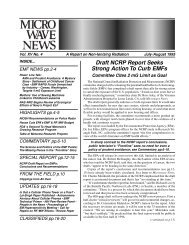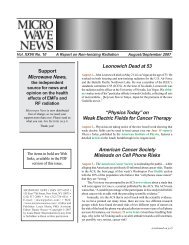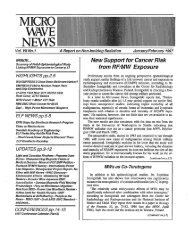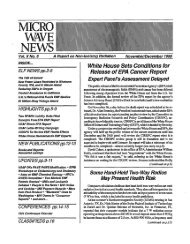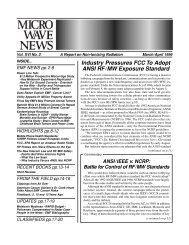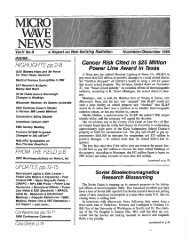Mobile Phones, Cancer Not Linked In Two Short ... - Microwave News
Mobile Phones, Cancer Not Linked In Two Short ... - Microwave News
Mobile Phones, Cancer Not Linked In Two Short ... - Microwave News
You also want an ePaper? Increase the reach of your titles
YUMPU automatically turns print PDFs into web optimized ePapers that Google loves.
HIGHLIGHTS<br />
self raised the possibility that they might reflect a thermal effect.<br />
Although the experiment was designed to maintain a constant<br />
temperature, he said then, it was conceivable that there had been<br />
“some localized heating in the medium, and hyperthermia is<br />
known to cause micronuclei” (see MWN, M/A99).<br />
“People are very interested in the details of their exposure<br />
system,” said Vijayalaxmi, “to see if there are any hot spots.”<br />
She noted in particular that at ILS, “the cells were exposed in<br />
the bottom of a test tube, a very narrow tube.” <strong>In</strong> contrast, she<br />
said, “<strong>In</strong> my exposure system, the cells are in a flask with a flat<br />
bottom. They are not piled on top of each other.”<br />
This January, Tice said that this issue would not be settled<br />
“until the same lab compares the results for test tubes and petri<br />
dishes—to see whether the geometry makes a difference.” He<br />
said that the hot-spots issue was a major focus at the FDA’s RF<br />
Micronucleus Working Group meeting in August 2000, and in<br />
the related request for proposals for further micronucleus studies<br />
issued by the CTIA (see MWN, N/D99 and J/A00).<br />
Tice, Roti Roti and Vijayalaxmi are all seeking funding from<br />
the CTIA–FDA partnership for replication of the initial WTR<br />
results. Vijayalaxmi and Roti Roti said that if they secured funding,<br />
they would carry out exposures at 10 W/Kg.<br />
Last summer, Kheem Bisht of Roti Roti’s lab presented initial<br />
results from a different study at the annual meeting of the<br />
Bioelectromagnetics Society (BEMS) in Munich. That experiment,<br />
which used mouse fibroblasts rather than human lymphocytes,<br />
did not find an effect at most exposure levels and durations.<br />
However, in six experiments there was a significant increase<br />
in the percentage of cells with micronuclei after a 24-hour<br />
exposure to a digital CDMA signal of 4.8-5.0 W/Kg. Exposures<br />
with a 5.1 W/Kg analog signal led to slight increases, but the<br />
differences with control cells were not significant.<br />
Bisht stated that while his results “do not show a clear RF<br />
effect,” the increases that were seen “could be consistent with<br />
the WTR data.” But in a January interview, Roti Roti seemed to<br />
back off from that conclusion. “That’s a case where we had no<br />
significant difference by the two-tailed t-test, but by the onetailed<br />
test it was significant,” he said. A one-tailed test is used to<br />
test a hypothesis which predicts a difference from controls in a<br />
given direction; a two-tailed test is used when researchers are<br />
equally interested in any change.<br />
“It could be something, or it could be due to random chance,”<br />
Roti Roti said. “That paper is under review, and we’re going to<br />
be rewriting it.”<br />
“Well, you’re not looking for a decrease in micronuclei,”<br />
responded Tice, “so it should be the one-tailed test.” <strong>In</strong> their BEMS<br />
presentation, Bisht and Roti Roti stated that their results were<br />
based on “six repeated experiments,” and Tice commented that<br />
“the real test is repeatability.”<br />
Vijayalaxmi said that in some ways, the whole issue is much<br />
ado about nothing. “To be honest,” she said, “who is going to be<br />
exposed to 10 W/Kg? Even a tower worker’s exposure is not<br />
supposed to go that high.” The duration of the experiment is<br />
also at odds with real-world experience, she said: “Who is going<br />
to sit and use a cell phone for 24 hours? Scientifically it is okay,<br />
but practically it is absurd.” The bottom line, she argued, is that,<br />
“Even if we see a positive effect or a negative effect it is mean<br />
ingless. It is not worth a dime in terms of people’s health.”<br />
“Our finding may or may not be biologically relevant,” said<br />
Tice. “But it’s damned reproducible.”<br />
<strong>In</strong> another paper in the January Radiation Research, Roti Roti<br />
reports that 0.6 W/Kg exposures showed no effect on carcinogenesis<br />
(see p.14).<br />
Although Vijayalaxmi’s paper in Radiation Research was an<br />
attempt to replicate the ILS findings, the latter have still not been<br />
published. Tice said that the ILS study, which was submitted to<br />
Bioelectromagnetics in August 2000, is currently under review<br />
(see MWN, S/O00).<br />
Supreme Court Rebuffs<br />
Challenge to U.S. Tower Policy<br />
On January 8, the U.S. Supreme Court declined to review<br />
the Federal Communications Commission’s (FCC) RF/MW radiation<br />
exposure rules or Congress’ 1996 preemption of state<br />
and local authority on wireless telephone tower siting.<br />
“Everybody understood that this was a long shot, but it was<br />
worth taking,” said Whitney North Seymour Jr. of Landy & Seymour<br />
in New York City. Seymour is representing a coalition of<br />
activists that wants states and towns to have the right to set RF/<br />
MW exposure rules stricter than those adopted by the FCC (see<br />
MWN, N/D97, J/A98, S/O98 and M/A00). The coalition includes<br />
the Council on Wireless Technology Impacts, based in Novato,<br />
CA, and the EMR Network, a national grassroots organization<br />
(see MWN, N/D98).<br />
Seymour asked the high court to reverse a federal appeals<br />
court that had ruled in favor of the federal tower policy (see MWN,<br />
S/O00). He contended that the preemption clause of the 1996<br />
Telecom Act violates the Constitution and usurps the authority<br />
of the states. Seymour also argued that the FCC’s exposure limits<br />
are not based on adequate research because Congress has not<br />
funded any RF/MW health effects studies at the Environmental<br />
Protection Agency since 1995 (see MWN, S/O95 and S/O00).<br />
Others who filed petitions to the Supreme Court challenging<br />
the federal policy were Michael Worsham, an attorney in Forest<br />
Hill, MD, David Fichtenberg, an activist in Olympia, WA, and<br />
the Cellular Phone Taskforce in New York City, a group that<br />
speaks on behalf of the electrosensitive.<br />
The court did not explain its decision. Seymour, a former U.S.<br />
Attorney in New York City, said in an interview that the decision<br />
“is not a comment on the issues we raised. It just means that<br />
the court didn’t have time to hear it.”<br />
The citizen groups were supported by the entire Vermont<br />
congressional delegation: Sen. James Jeffords (R), Sen. Patrick<br />
Leahy (D) and Rep. Bernie Sanders (<strong>In</strong>d.). All have sponsored<br />
bills to repeal the Telecom Act’s preemption clause—none of<br />
which has passed (see MWN, S/O99). “The ball is once again in<br />
our court,” the three legislators said in a joint statement on January<br />
12. “We will continue to push forward with our efforts in<br />
Congress to repeal this ill-formed legislation.”<br />
Janet Newton of Marshfield, VT, who heads the EMR Network,<br />
said she will work to promote a new legislative initiative.<br />
“Getting a bill passed will be an uphill struggle,” she conceded.<br />
MICROWAVE NEWS January/February 2001 8



